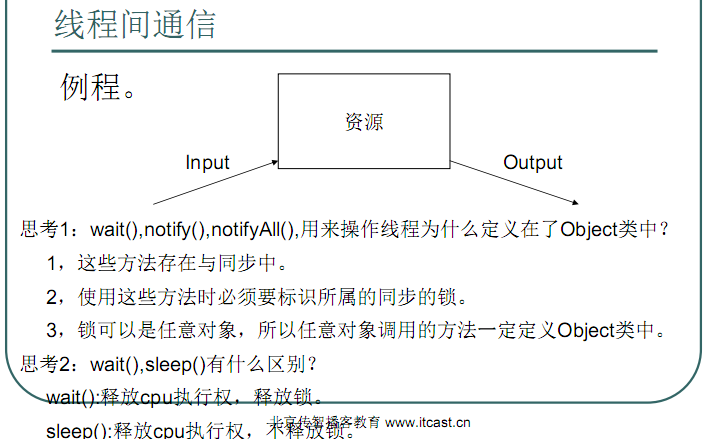知识点:线程间通信及安全问题、等待唤醒、线程间通信-生产者消费者、停止线程、守护线程、Join方法、优先级&yield方法
线程间通信
既:多个线程在处理同一资源,但任务不同
生产者消费者具体情况问题:
有一个数据存储空间,划分为两部分,一部分用于存储人的姓名,另一部分用于存储人的性别;
我们的应用包含两个线程,一个线程不停向数据存储空间添加数据(生产者),另一个线程从数据空间取出数据(消费者);
因为线程的不确定性,存在于以下两种情况:
*若生产者线程刚向存储空间添加了人的姓名还没添加人的性别,CPU就切换到了消费者线程,消费者线程把姓名和上一个人的性别联系到一起;
*生产者放了若干数据,消费者才开始取数据,或者是消费者取完一个数据,还没等到生产者放入新的数据,又重复的取出已取过的数据;
wait():让当前线程放弃监视器进入等待,直到其他线程调用同一个监视器并调用notify()或notifyAll()为止。
notify():唤醒在同一对象监听器中调用wait方法的任意一个线程。
notifyAll():唤醒在同一对象监听器中调用wait方法的所有线程。
wait 和 sleep 区别?
1,wait可以指定时间也可以不指定。
sleep必须指定时间。
2,在同步中时,对cpu的执行权和锁的处理不同。
wait:释放执行权,释放锁。
sleep:释放执行权,不释放锁。
这三个方法只能让同步监听器调用:
在同步方法中: this 调用
在同步代码块中: ()填写的对象 调用
wait()、notify()、notifyAll(),这三个方法属于Object 不属于 Thread,这三个方法必须由同步监视对象来调用,两种情况:
1.synchronized修饰的方法,因为该类的默认实例(this)就是同步监视器,所以可以在同步方法中调用这三个方法;
2.synchronized修饰的同步代码块,同步监视器是括号里的对象,所以必须使用该对象调用这三个方法;
可要是我们使用的是Lock对象来保证同步的,系统中不存在隐式的同步监视器对象,那么就不能使用者三个方法了,那该咋办呢?
此时,Lock代替了同步方法或同步代码块,Condition代替了同步监视器的功能;
Condition对象通过Lock对象的newCondition()方法创建;
里面方法包括:
await(): 等价于同步监听器的wait()方法;
signal(): 等价于同步监听器的notify()方法;
signalAll(): 等价于同步监听器的notifyAll()方法;
/*
等待/唤醒机制。
涉及的方法:
1,wait(): 让线程处于冻结状态,被wait的线程会被存储到线程池中。
2,notify():唤醒线程池中一个线程(任意).
3,notifyAll():唤醒线程池中的所有线程。
这些方法都必须定义在同步中。
因为这些方法是用于操作线程状态的方法。
必须要明确到底操作的是哪个锁上的线程。
为什么操作线程的方法wait notify notifyAll定义在了Object类中?
因为这些方法是监视器的方法。监视器其实就是锁。
锁可以是任意的对象,任意的对象调用的方式一定定义在Object类中。
*/
//资源
class Resource
{
String name;
String sex;
boolean flag = false;
}
//输入
class Input implements Runnable
{
Resource r ;
// Object obj = new Object();
Input(Resource r)
{
this.r = r;
}
public void run()
{
int x = 0;
while(true)
{
synchronized(r)
{
if(r.flag)
try{r.wait();}catch(InterruptedException e){}
if(x==0)
{
r.name = "mike";
r.sex = "nan";
}
else
{
r.name = "丽丽";
r.sex = "女女女女女女";
}
r.flag = true;
r.notify();
}
x = (x+1)%2;
}
}
}
//输出
class Output implements Runnable
{
Resource r;
// Object obj = new Object();
Output(Resource r)
{
this.r = r;
}
public void run()
{
while(true)
{
synchronized(r)
{
if(!r.flag)
try{r.wait();}catch(InterruptedException e){}
System.out.println(r.name+"....."+r.sex);
r.flag = false;
r.notify();
}
}
}
}
class ResourceDemo2
{
public static void main(String[] args)
{
//创建资源。
Resource r = new Resource();
//创建任务。
Input in = new Input(r);
Output out = new Output(r);
//创建线程,执行路径。
Thread t1 = new Thread(in);
Thread t2 = new Thread(out);
//开启线程
t1.start();
t2.start();
}
}
生产者消费者示例应用
/*
生产者,消费者。
多生产者,多消费者的问题。
if判断标记,只有一次,会导致不该运行的线程运行了。出现了数据错误的情况。
while判断标记,解决了线程获取执行权后,是否要运行!
notify:只能唤醒一个线程,如果本方唤醒了本方,没有意义。而且while判断标记+notify会导致死锁。
notifyAll解决了本方线程一定会唤醒对方线程的问题。
*/
class Resource
{
private String name;
private int count = 1;
private boolean flag = false;
public synchronized void set(String name)//
{
while(flag)
try{this.wait();}catch(InterruptedException e){}// t1 t0
this.name = name + count;//烤鸭1 烤鸭2 烤鸭3
count++;//2 3 4
System.out.println(Thread.currentThread().getName()+"...生产者..."+this.name);//生产烤鸭1 生产烤鸭2 生产烤鸭3
flag = true;
notifyAll();
}
public synchronized void out()// t3
{
while(!flag)
try{this.wait();}catch(InterruptedException e){} //t2 t3
System.out.println(Thread.currentThread().getName()+"...消费者........"+this.name);//消费烤鸭1
flag = false;
notifyAll();
}
}
class Producer implements Runnable
{
private Resource r;
Producer(Resource r)
{
this.r = r;
}
public void run()
{
while(true)
{
r.set("烤鸭");
}
}
}
class Consumer implements Runnable
{
private Resource r;
Consumer(Resource r)
{
this.r = r;
}
public void run()
{
while(true)
{
r.out();
}
}
}
class ProducerConsumerDemo
{
public static void main(String[] args)
{
Resource r = new Resource();
Producer pro = new Producer(r);
Consumer con = new Consumer(r);
Thread t0 = new Thread(pro);
Thread t1 = new Thread(pro);
Thread t2 = new Thread(con);
Thread t3 = new Thread(con);
t0.start();
t1.start();
t2.start();
t3.start();
}
}
/*
jdk1.5以后将同步和锁封装成了对象。
并将操作锁的隐式方式定义到了该对象中,
将隐式动作变成了显示动作。
Lock接口: 出现替代了同步代码块或者同步函数。将同步的隐式锁操作变成现实锁操作。
同时更为灵活。可以一个锁上加上多组监视器。
lock():获取锁。
unlock():释放锁,通常需要定义finally代码块中。
Condition接口:出现替代了Object中的wait notify notifyAll方法。
将这些监视器方法单独进行了封装,变成Condition监视器对象。
可以任意锁进行组合。
await();
signal();
signalAll();
*/
import java.util.concurrent.locks.*;
class Resource
{
private String name;
private int count = 1;
private boolean flag = false;
// 创建一个锁对象。
Lock lock = new ReentrantLock();
//通过已有的锁获取该锁上的监视器对象。
// Condition con = lock.newCondition();
//通过已有的锁获取两组监视器,一组监视生产者,一组监视消费者。
Condition producer_con = lock.newCondition();
Condition consumer_con = lock.newCondition();
public void set(String name)// t0 t1
{
lock.lock();
try
{
while(flag)
// try{lock.wait();}catch(InterruptedException e){}// t1 t0
try{producer_con.await();}catch(InterruptedException e){}// t1 t0
this.name = name + count;//烤鸭1 烤鸭2 烤鸭3
count++;//2 3 4
System.out.println(Thread.currentThread().getName()+"...生产者5.0..."+this.name);//生产烤鸭1 生产烤鸭2 生产烤鸭3
flag = true;
// notifyAll();
// con.signalAll();
consumer_con.signal();
}
finally
{
lock.unlock();
}
}
public void out()// t2 t3
{
lock.lock();
try
{
while(!flag)
// try{this.wait();}catch(InterruptedException e){} //t2 t3
try{cousumer_con.await();}catch(InterruptedException e){} //t2 t3
System.out.println(Thread.currentThread().getName()+"...消费者.5.0......."+this.name);//消费烤鸭1
flag = false;
// notifyAll();
// con.signalAll();
producer_con.signal();
}
finally
{
lock.unlock();
}
}
}
class Producer implements Runnable
{
private Resource r;
Producer(Resource r)
{
this.r = r;
}
public void run()
{
while(true)
{
r.set("烤鸭");
}
}
}
class Consumer implements Runnable
{
private Resource r;
Consumer(Resource r)
{
this.r = r;
}
public void run()
{
while(true)
{
r.out();
}
}
}
class ProducerConsumerDemo2
{
public static void main(String[] args)
{
Resource r = new Resource();
Producer pro = new Producer(r);
Consumer con = new Consumer(r);
Thread t0 = new Thread(pro);
Thread t1 = new Thread(pro);
Thread t2 = new Thread(con);
Thread t3 = new Thread(con);
t0.start();
t1.start();
t2.start();
t3.start();
}
}
API示例
class BoundedBuffer {
final Lock lock = new ReentrantLock();
final Condition notFull = lock.newCondition();
final Condition notEmpty = lock.newCondition();
final Object[] items = new Object[100];
int putptr, takeptr, count;
public void put(Object x) throws InterruptedException {
lock.lock();
try {
while (count == items.length)
notFull.await();
items[putptr] = x;
if (++putptr == items.length) putptr = 0;
++count;
notEmpty.signal();
} finally {
lock.unlock();
}
}
public Object take() throws InterruptedException {
lock.lock();
try {
while (count == 0)
notEmpty.await();
Object x = items[takeptr];
if (++takeptr == items.length) takeptr = 0;
--count;
notFull.signal();
return x;
} finally {
lock.unlock();
}
}
}
停止线程
*1.定义循环标记
*因为线程运行代码一般都是循环,只要控制了循环即可
*2.使用interrupt(中断)方法
*该方法是结束线程的冻结状态,使线程回到运行状态来
注:stop已经过时不再使用
/*
停止线程:
1,stop方法。(不能用)
2,run方法结束。
怎么控制线程的任务结束呢?
任务中都会有循环结构,只要控制住循环就可以结束任务。
控制循环通常就用定义标记来完成。
但是如果线程处于了冻结状态,无法读取标记。如何结束呢?
可以使用interrupt()方法将线程从冻结状态强制恢复到运行状态中来,让线程具备cpu的执行资格。
当时强制动作会发生了InterruptedException,记得要处理
*/
class StopThread implements Runnable
{
private boolean flag = true;
public synchronized void run()
{
while(flag)
{
try
{
wait();//t0 t1
}
catch (InterruptedException e)
{
System.out.println(Thread.currentThread().getName()+"....."+e);
flag = false;
}
System.out.println(Thread.currentThread().getName()+"......++++");
}
}
public void setFlag()
{
flag = false;
}
}
class StopThreadDemo
{
public static void main(String[] args)
{
StopThread st = new StopThread();
Thread t1 = new Thread(st);
Thread t2 = new Thread(st);
t1.start();
t2.setDaemon(true);
t2.start();
int num = 1;
for(;;)
{
if(++num==50)
{
// st.setFlag();
t1.interrupt();
// t2.interrupt();
break;
}
System.out.println("main...."+num);
}
System.out.println("over");
}
}
jion()方法、setDeamon方法(设置一个后台线程,随着其他线程消亡而消亡)、yield方法(临时暂停 执行一次任务后自动放弃执行权)
/*
join:
当A线程执行到了B线程的.join()方法时,A就会等待。等B线程都执行完,A才会执行。
join可以用来临时加入线程执行。
*/
class Demo implements Runnable
{
public void run()
{
for(int x=0; x<50; x++)
{
System.out.println(Thread.currentThread().toString()+"....."+x);
Thread.yield();
}
}
}
class JoinDemo
{
public static void main(String[] args) throws Exception
{
Demo d = new Demo();
Thread t1 = new Thread(d);
Thread t2 = new Thread(d);
t1.start();
t2.start();
// t2.setPriority(Thread.MAX_PRIORITY);
// t1.join();//t1线程要申请加入进来,运行。临时加入一个线程运算时可以使用join方法。
for(int x=0; x<50; x++)
{
// System.out.println(Thread.currentThread()+"....."+x);
}
}
}
























 被折叠的 条评论
为什么被折叠?
被折叠的 条评论
为什么被折叠?








